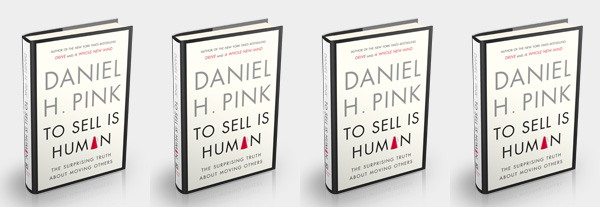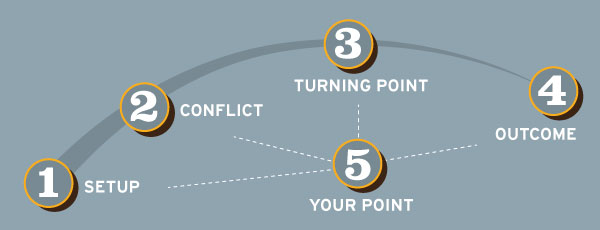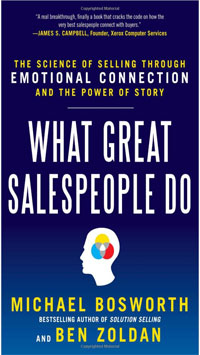
by davidlecours | Oct 15, 2013 | Experience Marketing, Story, Strategy

I recommend To Sell Is Human by Daniel Pink to anyone in the A/E/C industry because, as the book says, “we’re all in sales now.” Many A/E/C firms claim that “everyone in the firm sells,” but they rarely offer sales training. This book fills that knowledge gap, even for those that don’t think of themselves as salespeople.
This summary highlights the why, what, and how to apply the core concepts of the book.
WHY
1) Like it or not, we’re all in sales now.
2) Sales has changed more in the last 10 years than in the previous 100.
WHAT
ABC used to stand for Always Be Closing. According to Pink, ABC now refers to Attunement, Buoyancy, and Clarity.
Attunement “” The capacity to take someone’s view and calibrate your words and actions to match. Proposals and Presentation Interviews need to be attuned to our buyer’s challenges. If the RFP is written using specific language, then selectively adopt that language in your response to demonstrate an understanding of their challenges.
Buoyancy “” The capacity to stay afloat in “an ocean of rejection.” After pursuit losses, Pink recommends interrogative self-talk. During your next go/no go deliberation, interrogate yourself. Ask “can we deliver this project with excellence? If yes, then list the top 5 reasons why. Use these 5 reasons inspire your proposal and presentation.
Clarity “” Making sense in murky situations. Pink defines this as problem finding, then problem solving. Teams that win frequently make recommendations about potential project problems that the client hadn’t even considered.
HOW
Pitch, Improvise and Serve are how to apply the new ABCs of sales.
Pitch “” Summarizing the essence of your project pursuit into a memorable tagline or phrase can help your message stick. According to Pink, rhyming “taste great and goes down easily.” A great resource to help with rhymes isrhymezone”‹.com.
Story is another brilliant way to pitch. Story is memorable, powerful, and emotional. Big decisions are made on emotion, then later justified with fact.
Improvise “” To Sell is Human reminds us that there are three main rules in Improv. Hear offers, say “yes and,” and make your partner look good. Being a great marketer means being a great listener. Making your partner look good can be directly applied to presentation interviews. Not only are selection panels listening for what you say, but they also observe how your team interacts. Making fellow team members look good communicates that you will make your client look good.
Serve “” Pink reminds us to make our work both personal and purposeful while serving others. By understanding your client’s personal hopes, dreams. fears and insecurities, you will offer better solutions. Also, ask why a pursuit matters to you and your team. Then share your answers in proposals and interviews. If your purpose for pursuing a project improves quality of life or improves the world, then your team now has an inspired mission.
What’s your reaction when you think of a sales person? The terms most often used are “pushy, slimy, slick, obnoxious, etc.” This is the old model of sales, trying to convince buyers. Nobody likes to feel manipulated. To Sell is Human offers a new model. A model based on emotional intelligence, purpose and service. Since we’re all in sales now, it’s nice to know we can use our powers for good

by davidlecours | Nov 13, 2012 | Story

Marketers are buzzing about “story.” Ten years ago, we were frothing about “branding.” Like “branding,” I’m concerned that the term “story” is being applied too liberally, and will lose its credibility. To avoid this, we need to be precise when referring to “story.” Story has a definite structure. By learning this timeless structure, all AEC marketers can better tell stories to win new business.
Robert McKee, a Fulbright Scholar praised in Hollywood for his consulting on narrative structure defines story as “the expression of how and why life changes. A story begins with balance, then something throws life out of balance, then a story goes in to describe how balance is restored.”
In previous posts, I shared why AEC Marketers should use story (the why), and the three stories we must master (the what). Now, I’ll recommend how to craft your stories (the how). Story structure will make your stories, and firm, more memorable. Stories move a prospect along the continuum of getting to know, like, and trust you, and your firm. Well constructed stories filled with emotion and vulnerability build relationships. As you know well, relationships win new business.
Story Structure 101
After reading a gripping novel or seeing a moving film, have you ever wondered if there is a secret formula for story success? There is, and it’s no secret. You may have heard of the famous 3 act play: Introduction, Rising Action, Resolution. I prefer the structure below from What Great Salespeople Do: The Science of Selling Through Emotional Connection and the Power of Story by Mike Bosworth and Ben Zoldan. These 5 stages are the “secret sauce” for all great stories. I’ll use an example of an AEC “Who We’ve Helped Story” to illustrate these 5 stages.
- Setup – This is where you drop your listener into your story. Quickly ntroduce your characters, location, and any relevant background information. To make your protagonists likable, share what makes them human (dreams, fears, desires, etc.). The audience needs to connect with your project team and want them to succeed.
- Conflict – If there is no struggle, there is no plot. It just isn’t interesting. There needs to be something formidable that stands in the way of your project team’s success. In the AEC world, this could be timing, personalities, budget, politics, or physical constraints.
- Turning Point – Stories are explanations of how and why life changes. This is the aha moment that changes your team. This could be some new insight that alters how your team solves problems on the job site, or the reason why you entered a new market. The turning point could even be an epiphany that changed the strategic direction of your firm.
- Outcome – This is an untangling of events in your story. Think of movie credits rolling where we learn what your favorite characters are doing with their lives today. The resolution explains how your story ends and what effect the experience has had on your team.
- Your Point – In this stage, you reinforce your theme or point of your story. This is often a core belief or value that your firm holds. If your firm has a new way of delivering projects, this is where you would share that process. It might sound something like this, “as a result of what we learned by continuously overcoming X, our firm believes that Y not only is the best way to deliver projects, but it also separates us from our competition.

Recommended Story Development Process
The way in which you develop a good marketing story is not the order in which you ultimately write or tell that story. Because clarity and brevity are so important in marketing stories, write or tell the story in chronological order (stages 1 thru 5 above). Develop the story in this order:
- Your Point – Ask yourself, “why am I/we telling this story?” Possible answers may be to share your impressive safety record, demonstrate your creativity, or persuade that your project delivery method saves money. Always start with why.
- Outcome – To make sure your story ends in a way that supports your point.
- Setup
- Conflict
- Turning Point
Now you have the key elements, practice writing or telling the story in chronological order.
Share Emotion
Great story structure without emotion is like a jumpy house before it’s been inflated. Emotion gives it life, makes it interesting, and ultimately memorable. There are 6000 words in English to communicate emotion. Use them to describe how your main characters feel, not just what happened. If you just recount the facts, expect to put your audience to sleep. Consistently ask yourself, how did your protagonist feel at each stage of the story. Feelings are the glue that constructs real and likable characters. Emotional connection is also what makes your story, and your firm memorable.
Reveal Vulnerability
This is the hardest thing to do for AEC firms. Our work is so highly technical, and we are consistently asserting our expertise, that to reveal vulnerability seems weak. But we actually gain power when revealing vulnerability. Try this with a friend. Reveal something you may be struggling with, or a mistake you’ve made and watch what happens. Because of what neuroscientists call mirror neurons, your friend will most likely share something vulnerable in return. In simple terms, this “monkey see, monkey do” behavior is a mutual exchange of emotion. This is the definition of a relationship. By telling your story, your prospect may tell you their story. This is where you learn what your prospect’s pain points are, and what you can do to solve them. It takes courage, but going first in revealing vulnerability, is critical. You establish that it’s safe to be real, that your prospect can trust you with their authentic story. It’s counterintuitive, but vulnerability makes you more likable, not less. Perfection is boring, stiff, and lifeless. It’s our imperfections, that make us likable. Stories about when your firm made a mistake, what you did to correct that error, and what you learned, are incredibly powerful relationship builders.
Nothing is more intimidating to a writer than a blank sheet of paper. My intention is that this post serves as a template for you to jump-start your stories. By utilizing a proven story structure, and integrating emotion and vulnerability, you will create stories that elevate your firm’s proposals, presentation interviews, and websites to win new business.
What Do You Think?
Does having a structure constrain or enhance your creative storytelling?
Any examples of where you’ve revealed vulnerability, and it’s helped or hurt you?
Related Posts
Why AEC Marketers Must Master The Power of Story (The Why)
3 Stories AEC Marketers Must Master (The What)
Recommended Books on The Power of Story To Win New Business
What Great Salespeople Do: The Science of Selling Through Emotional Connection and the Power of Story by Mike Bosworth, Ben Zoldan
The Story Factor by Annette Simmons
Tell to Win: Connect, Persuade, and Triumph w/ Hidden Power of Story by Peter Guber
resonate: Present Visual Stories that Transform Audiences by Nancy Duarte
Made to Stick: Why Some Ideas Survive and Others Die by Dan and Chip Heath
by Dan and Chip Heath
A Whole New Mind: Why Right-Brainers Will Rule the Future by Dan Pink
by Dan Pink

by davidlecours | Aug 14, 2012 | Story

As AEC Marketers, we are in the business of persuasion. Aristotle, the father of persuasion, defined it is a combination of logic (logos), emotion (pathos) and credibility (ethos). Our industry is really good at two out of three of these tactics: logic and credibility. But 67% would earn us a “D” if enrolled in Persuasion class. We must connect emotionally to be fully effective. Story is the perfect vehicle custom-built to deliver emotion.
Is emotional connection too squishy, warm & fuzzy, Kumbaya for the AEC industry? No, we are already using it. Our industry is built on relationships. How are relationships built? By creating positive emotional connections one person at a time.
Stories Help Us Lead
Quick, who are the greatest leaders in American history? I’ll wait for you to list three. Your list might include Kennedy, Lincoln, or Martin Luther King because a common skill among great leaders is the ability to tell stories. This extends beyond politics. When musicians, actors and athletes use story: as defined as authentic expression that moves audiences on an emotional level, they become idols. While our goal may not be hero worship, storytelling helps us lead in business too. Beth Comstock, Chief Marketing Officer of GE says, “you must first tell a story, before you can sell a story.” Leadership and storytelling are inseparable. Plato said, “people that tell stories rule the world.” Which market would you like to rule?
Story Allows Us In
Nobody likes to be sold. We feel manipulated. Our audience keeps their defenses up against our persuasive charm. But story can let you in. When people listen to, or read a story, they become physically more receptive. They relax their shoulders, release their jaw, and even lower their heartbeat. Story also induces mental relaxation. Listeners become less analytical and can reach a trance-like state. This is why parents read stories to their children before bedtime. Story connects to the subconscious and imagination centers of the brain. Story, like a Trojan Horse, gets us inside the gate to then move our audience to act.
Story Moves Our Audience to Buy
Human beings liked to be moved on an emotional level. It makes us feel alive. We seek out emotional experiences on the page, stage, screen and stadium to escape from our overly logical lives. While logic makes people think, emotion makes people act. We purchase using emotion and later justify with fact. Think about the last big purchase you made. Maybe it was a house or a car. Sure, you did logical research. If you are really nerdy, you created a spreadsheet comparing positive and negative attributes among your choices. But, when you had to decide, you probably went with your gut. You walked into your new house and it just felt right. Selection committees don’t choose a firm solely based on lowest fee (a logical decision). Emotional connection, a feeling that the team will be great to work with, influences the final decision.
As Professional Service Marketers, all we sell is a promise to deliver. This promise must be credible (your firm’s reputation) and logical (proven project delivery method). These two attributes will get you on a short list. Harnessing the power of story to connect emotionally can win you the work.
Next Post To Read
How to Craft AEC Stories To Win New Business
The 3 Stories AEC Marketers Must Master
Books That Have Informed My Thinking on Storytelling To Win New Business
What Great Salespeople Do: The Science of Selling Through Emotional Connection and the Power of Story by Mike Bosworth, Ben Zoldan
Winning the Story Wars: Why Those Who Tell the Best Stories Will Rule the Future by Jonah Sachs
The Story Factor by Annette Simmons
Tell to Win: Connect, Persuade, and Triumph with the Hidden Power of Story by Peter Guber
resonate: Present Visual Stories that Transform Audiences by Nancy Duarte
Made to Stick: Why Some Ideas Survive and Others Die by Dan and Chip Heath
by Dan and Chip Heath
A Whole New Mind: Why Right-Brainers Will Rule the Future by Dan Pink
by Dan Pink
Your Thoughts?
Has your firm used story to win new business?
When have you used story? In bios, project sheets, firm overviews, presentation interviews?
Do you find written or oral stories to be more effective?
by davidlecours | Apr 1, 2010 | Strategy

A lot of firms struggle with choosing a market sector in which to focus their marketing efforts. To build your brand, you need to identify the type of work you seek. This declaration should be formalized in a strategic plan. But don’t let this scare you. Strategic planning has a reputation for being difficult, complicated and time consuming. Typically the process begins with a SWOT analysis looking at your Strengths, Weaknesses, Opportunities and Threats. Here is a simplified version focusing on your strengths.I recently had an opportunity to see Chip Heath speak about his new book Switch. Chip, along with his brother Dan, also wrote the fantastic Made To Stick. In Switch, they introduce a concept called “Find the Bright Spots.” Bright spots, as applied to your marketing, are successful efforts that you’ve already been doing, and simply repeating them.
Create Your Top 10
First, make a list of the top 10 projects you’ve ever worked on. Yes, I know “top” is ambiguous and purposely so. To be meaningful, YOU need to define top. Top could mean revenue, creativity, great people, fun, social good, publicity or some combination thereof. Whatever your definition of top is, it must embody the type of projects that you’d love to work on next. Marketing is all about the work that you seek.
Discover What’s Working
Next, create a grid with your top 10 projects listed down the left side. Across the top, list the following questions to ask about each project:
How did this client learn about your firm?
Why were you hired? What other reasons did they hire you?
Type of project by service?
Type of client by vertical market (biotech or tourism for example)?
What time of year were you hired?
Any professional affiliations of the key decision makers?
Gender and age of the key decision makers?
You should be asking these important questions each time you get hired (and not hired). There is no expiration date on asking. Don’t assume why you get hired and then go out and repeat the wrong the things.
Let The Patterns Define Your Strategy
As you can imagine, you are looking for patterns to emerge in the grid you’ve created above. If you notice a large percentage of projects in a certain vertical market, this defines your niche. A certain service that shows up frequently can further define your speciality. If you see a pattern of why you get hired, then this becomes the positioning for your next ad campaign, tagline and website messaging. The goal is to market “with the flow” of what you are already doing well.
I know there are bright spots in your marketing or you wouldn’t be in business. Don’t focus on the problems. Yes, there is something innately satisfying about figuring out what’s broken and then fixing it. But if you focus on what is working, the “bright spots,” this path of least resistance will bring you successwith greater ease.
What Do You Think?
What insights did gain from creating your Top 10 list?
Are there other areas of your business that you can leverage what is already working?
How could you apply these principles to your life?
Similar Posts
3 Tips For a Better Marketing Plan
Marketing Planning 101
|
by davidlecours | Feb 11, 2009 | Branding, Strategy
As Professional Service Marketers, we have the challenge of persuading prospects to purchase something that doesn’t exist. Prospects cannot “test drive” their future multi-million dollar building. Sure, you can show past projects, but that doesn’t guarantee future success. Especially if the project incorporates new technology.
The solution to this dilemma is to have a unique project delivery process that demonstrates your ability to solve problems and deliver successful projects. This communicates to the prospective client, “we don’t know all the answers to the questions your project may present. But, we have a proven process that consistently allows us to find the right answers.” By showing how you’ve helped other clients with your unique process, you put the prospect at ease, and you differentiate your firm from your competition.
1. Process Defined
Process is simply your project delivery method spanning from initial meeting through the life cycle of the building.
2. Why Brand Your Process?
There are many reasons to make your process a persuasive tool to convince clients to select your firm. First, services like Architecture, Engineering, and Contracting are simply a promise. So, we need to empathize with the scary leap of faith our clients make in entrusting us to deliver on our promise. A proven process helps to soothe client fears during the emotional sales cycle. Also, process is an opportunity to differentiate you from your competition. Process is scalable and can be implemented at firms sized from 1″“1000 to reinforce brand consistency across all branch offices. Finally, process is an asset that can live beyond the founding principals of your firm. This can add value in the event of ownership transition, merger or acquisition.
3. Develop, Articulate and Brandâ„ Your Process
Begin with listing the various steps your firm goes through to successfully complete a project. Determine all the key checkpoints for quality assurance. As you make this list, filter it through the positioning of what makes your firm unique. In other words, don’t focus on things that everyone else does. Work with a writer or brand communications firm to articulate your process in a way that is simple and compelling to a prospective client. Then brand it with a memorable name and even register it as a service mark. Our process, called The Joy of Six, is described in greater detail here. I recommend a circular process to close the loop by measuring results of the completed project. This informs an improved next project and hopefully get you re-hired.
4. Demonstrate How Your Process Yields Success
When meeting with prospective clients, don’t just show a portfolio of completed projects. Demonstrate how you reach successful results by presenting highlights of each project phase in the context of your newly branded process. Show sketches, talk about overcoming challenges, and share how intelligence gained in one project phase informs success in the next. When a prospect sees how your process delivers on past promises, it plants the seed of future success in in that prospect’s mind.
FREE .pdf of this advice






